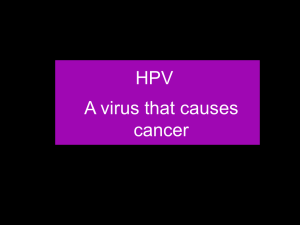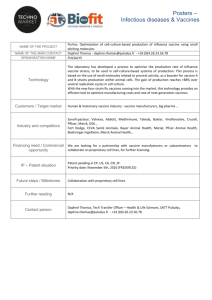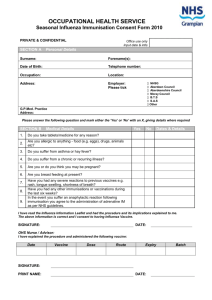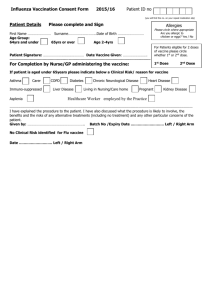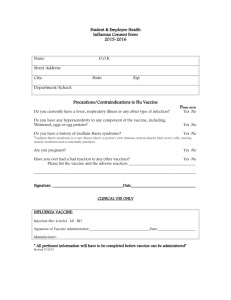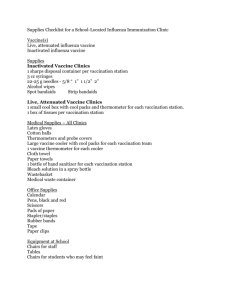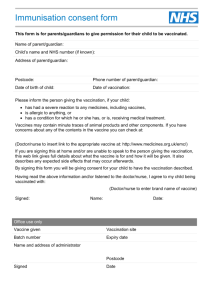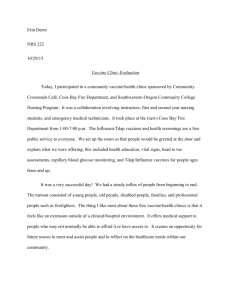Adult Immunizations
advertisement
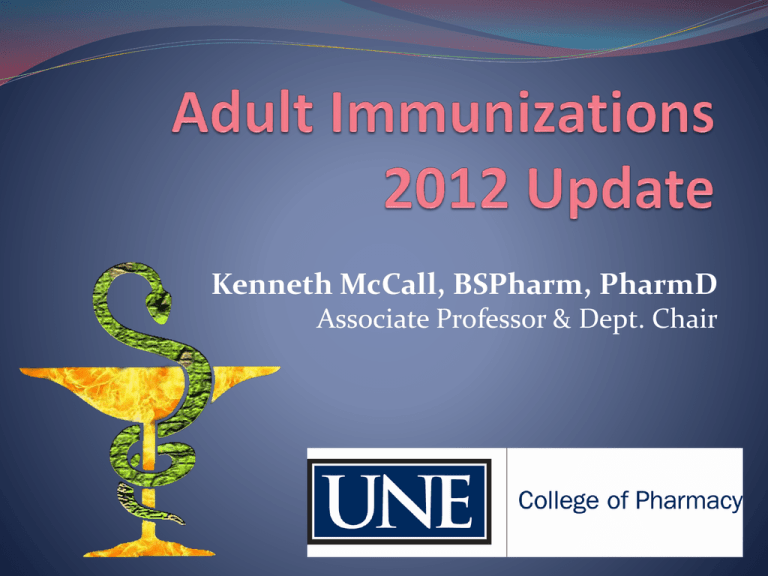
Kenneth McCall, BSPharm, PharmD Associate Professor & Dept. Chair Disclosure I, Kenneth McCall, do not have an interest in selling a technology, program, product, and/or service to CME/CE professionals. I am a speaker for Merck Vaccines. Objectives Discuss the gap between current rates and Healthy People 2020 goals for vaccinations. Categorize each of the CDC recommended vaccines based upon live/inactivated, route, prep., and storage. Recognize vaccine-preventable pathogens by common name, classification, and transmission. Discuss the influenza vaccines for 2012 including the new High-Dose and Intradermal vaccines. Identify vaccine contraindications and recommend vaccines based upon age and medical history. Apply ACIP recommendations and FDA approved indications for the CDC recommended vaccines. Outline Background & Principles of Vaccination Influenza Pneumonia Herpes zoster Immunization Resources The Pink Book http://www.cdc.gov/vaccines/pubs/pinkbook/index.html Adolescent and Adult Vaccine Quiz http://www2a.cdc.gov/nip/adultImmSched/ Screening Questionnaire http://www.immunize.org/catg.d/p4065.pdf The Yellow Book http://wwwnc.cdc.gov/travel/ 1-800-CDC-INFO Apps ACP Immunization Advisor CDC Vaccine Schedule for Adults Second Regular Session – 125th Maine Legislature LD 1608 “An Act to Clarify the Laws Governing Pharmacy Interns” Sponsored by Speaker Bob Nutting “…authorized to engage in the practice of pharmacy while under the direct supervision of a licensed pharmacist.” LD 1715 “An Act for Timely Access to Enhanced Administration of All Vaccines” Sponsored by Representative Meredith Strang Burgess “‘Practice of pharmacy’ means…the administration of vaccines licensed by the US FDA that are recommended by the US CDC ACIP for administration to adults…” “A pharmacy may operate a vaccine administration clinic inside, outside, or off the pharmacy’s premises…with one-time board approval” Pharmacist Administered Vaccines Types of Vaccines Authorized to Administer Based upon APhA / NASPA Survey of State IZ Laws/ Rules (updated March 2012) Any vaccine AL*, AK*, AZ*, AR*, CA, CO, DC*, DE*, GA*, HI*, ID,IL, IN*, IA*, KS, KY, LA*, ME, MI*, MN, MS, MT, NE, NV ,NJ*, NM, NC, ND, OK, OR, PA, RI, SC*, TN, TX, VT, VA*, WA, WI Influenza Only FL, MA, PR Influenza and Pneumo NY Number of states / territories 9 Other combos 1 Influenza & Pneumo Influenza Only 3 Any vaccine 40 35 30 25 20 15 10 5 0 39 Number of states / territories Other combos OH, CT, MD,MO, NH, SD, UT, WV, WY * Via Rx for some; ** broad list of vaccines Pharmacist Administered Vaccines May student interns administer vaccines? Based upon APhA / NASPA Survey of State IZ Laws/ Rules (updated March 2012) Number of states / territories allowing 34 States / territories not authorized 19 (AK, CO, CT, DE, FL,IN, MA, MN, ND, NH, NJ, NY, PA, PR, SC, SD, WV) Criteria common among states •Student must be trained (complete Certificate Training Program) • Operating under supervision of trained pharmacist Principles of Vaccination* Passive immunity Transplacental Breast milk Blood products Active immunity Infection Vaccination *Epidemiology and Prevention of Vaccine-Preventable Diseases, 12th Edition Classification of Vaccines Live attenuated Weakened form of the “wild” virus or bacteria Inactivated Whole viruses or bacteria Fractions of viruses or bacteria *Epidemiology and Prevention of Vaccine-Preventable Diseases, 12th Edition Classification of Vaccines Live attenuated: Measles, mumps, rubella, varicella, zoster, intranasal influenza Inactivated: hepatitis A, hepatitis B, influenza, pneumonia, diphtheria, tetanus, pertussis, HPV, meningicoccal *Epidemiology and Prevention of Vaccine-Preventable Diseases, 12th Edition Timing & Spacing of Vaccines All vaccines can be administered at the same visit as all other vaccines. Individual vaccines should not be mixed in the same syringe. When live vaccines (MMR, Varicella, Zoster, and Flumist) are not administered at the same visit, they should be separated by at least 4 weeks. All other combinations of two inactivated vaccines, or live and inactivated vaccines may be given at any time before or after each other. Increasing the interval between doses of a multidose vaccine does not diminish the effectiveness of the vaccine. Decreasing the interval between doses of a multidose vaccine may interfere with antibody response and protection. *Epidemiology and Prevention of Vaccine-Preventable Diseases, 12th Edition A healthcare provider requests a flu shot, MMR, and varicella vaccine. Which of the following statement about the timing of the vaccines is true? 25% 1. All three , separate syringes, same day 25% 2. All three, mix in 1 syringe, same day 25% 3. Must separate MMR and varicella by 4 wk 25% 4. Must separate MMR and varicella by 7 day An 12-year-old girl received the first dose of the HPV vaccine six months ago. The recommend HPV series is a second dose 1-2 mos after first and third dose at least 3 mos after second. What would you recommend to the parent? 25% 1. The vaccine is no longer indicated 25% 2. Start the series over and repeat first dose 25% 3. Give 2nd dose today; 3rd dose in 1 month 25% 4. Give 2nd dose today; 3rd dose in 3 mos. Low Adult Vaccination Rates Are in Contrast to the High Rates Among US Children Vaccination is one of the 10 greatest public health achievements of the 20th century1 Childhood vaccination rates remain at or near highest levels in the United States, but many adults are not vaccinated as recommended2,3 “Although >90% of young children have received the individual vaccines recommended for them, coverage for adult vaccines can range from 26% to 65%, depending on the vaccine and the target population.”2 —Infectious Diseases Society of America 1. Centers for Disease Control and Prevention (CDC). MMWR Weekly Rep. 1999;48(12):241–243. 2. Infectious Diseases Society of America. Clin Infect Dis. 2007;44:e104–e108. 3. Centers for Disease Control and Prevention (CDC). MMWR Weekly Rep. 2009;58(33):921–926. 4 17 18 Perceived Challenges to Adult Vaccination: Survey1,a Patient Reasons Health Care Provider Perceptions “Doctor hasn’t told me I need it” Not knowing when to get it The belief that a healthy person doesn’t need it Financial concerns were not a deterrent for most Side effects Dislike of needles Lack of insurance coverage Lack of knowledge about disease prevention Most patients indicated that they were likely to receive a vaccination if their health care provider recommended it. aA recent survey was conducted to identify the reasons adult patients may decide to NOT receive vaccinations and health care providers’ perceptions regarding patients NOT being vaccinated. Consumers (N = 2,002) and health care providers (N = 200) completed structured telephone interviews, e-mails, or faxes emphasizing tetanus, influenza, and pneumococcal vaccines. 1. Johnson DR et al. Am J Med. 2008;121(Suppl 2):S28–S35. 47 Recommended Adult Immunization Schedule, by vaccine and age group < -------------TIV or LAIV--------- > TIV or TIV HD < -----------------------------TIV or TIV ID-------------------------------- > FDA approved age 50+ yrs Vaccines that might be indicated for adults based on medical and other indications Smoker College Dorm / Military Recruit 23 Influenza Virus Strains Influenza A virus Moderate to severe illness All age groups Humans and other animals Influenza B virus Milder disease Primarily affects children Humans only Influenza C virus Rarely reported in humans No epidemics Seasonal influenza vaccine contains 2 type-A and 1 type-B 24 Estimated Influenza Vaccination Coverage: 2010-11. 100 90 80 70 60 50 40 30 20 10 0 HP 2020 US New England Maine Children Adults 18- Adults 50- Adults >65 Adults 1864 yrs at 49 yrs 65 yrs yrs high risk† †Persons with asthma, diabetes, or heart disease MMWR / June 10, 2011 / Vol. 60 / No. 22 2012-13 ACIP/CDC Recommendations Routine influenza vaccination continues to be recommended for all persons aged ≥6 months. While the H1N1 virus is the same as the 2011-2012 recommendation, the recommended influenza H3N2 and B vaccine viruses are different from those recommended for the Northern Hemisphere for the 2011-2012 influenza vaccine. Persons aged ≥65 years can be administered any of the standard-dose inactivated vaccine or Fluzone High-Dose. A new intradermally administered TIV preparation, Fluzone Intradermal, was licensed in May 2011 for adults 18 to 65. http://www.cdc.gov/mmwr/preview/mmwrhtml/mm6132a3.htm?s_cid=mm6132a3_e 26 US Influenza Vaccines: 2012-13 Vaccine Inactivated, Standard Dose Inactivated, High Dose Inactivated, Intradermal Live, Intranasal Age Group Dosage Schedule Route 6-35 mos 0.25 ml 1 or 2 shots IM 3-8 years 0.5 ml 1 or 2 shots IM >9 years 0.5 ml 1 shot IM >65 years 0.5 ml 1 shot IM 18-64 years 0.1 ml 1 shot ID 2-8 years 0.2 ml 1 or 2 doses Nasal 9-49 years 0.2 ml 1 dose Nasal http://www.cdc.gov/mmwr/preview/mmwrhtml/mm6132a3.htm?s_cid=mm6132a3_e#tab Recommendations regarding influenza vaccination for persons who report allergy to eggs 29 Live Attenuated Influenza Vaccine Indication Healthy people 2 through 49 years of age Contraindications I pick my nose! Pregnant women People who have long-term health problems with: heart disease kidney or liver disease lung disease metabolic disease, such as diabetes asthma anemia, and other blood disorders Anyone with a weakened immune system Severe egg allergy 30 Live Attenuated Influenza Vaccine Adverse Reactions Runny nose or nasal congestion Fever > 100°F in children 2-6 years of age Sore throat in adults Wheezing and hospitalization in children < 2 years old Administration Flumist®: 0.1-mL dose in each nostril Intranasal 32 Flumist Quadrivalent ® In February 2012, FDA approved a new seasonal quadrivalent LAIV, FluMist Quadrivalent (MedImmune). This vaccine currently is not anticipated to be available until the 2013–14 influenza season. All currently available influenza vaccines are trivalent and contain A(H1N1), A(H3N2), and B viral antigens. There are two antigenically distinct lineages of influenza B viruses referred to as Victoria and Yamagata lineages. 34 Methods: Multicenter, randomized, double-blind controlled study HD vaccine (60 mcg of hemagglutinin per strain): N=2,575 SD vaccine (15 mcg of hemagglutinin per strain): N=1,262 in adults 65 years of age and older. J Infect Dis. 2009;200(2):172-80 35 antibody titer level Comparison of responses to high-dose (HD) and standard-dose (SD) influenza vaccine 140 700 120 600 100 500 80 400 60 300 40 200 20 100 0 0 SD A/H1N1 B J Infect Dis. 2009;200(2):172-80 HD A/H3N2 36 Comparison of systemic side effects to HD and SD influenza vaccine 25 Percent 20 15 SD HD 10 5 0 Fever Headache Malaise J Infect Dis. 2009;200(2):172-80 Myalgia 37 Administration Fluzone HD®: 0.5-mL dose IM - deltoid 1 inch, 25 gauge needle 38 A 30-year-old healthy male requests an annual flu shot. He has no allergies. His wife is currently pregnant. Which flu vaccine(s) is/are appropriate? 0% 1. Influenza intradermal vaccine 0.1 ml 0% 2. Influenza SD shot 0.5 ml IM 0% 3. Influenza HD shot 0.5 ml IM 0% 4. Flumist nasal spray 0.1 ml in each nostril 0% 5. Either 1 or 2 0% 6. Either 3 or 4 0% 7. Either 1, 2 or 4 Intradermal Influenza Vaccine Indication Persons 18 through 64 years of age Contraindications Severe egg allergy 41 Intradermal vs Traditional IM needle Length 30 Gauge Needle and Less Volume Methods: Multicenter, randomized, double-blind controlled study ID vaccine (9 mcg of hemagglutinin per strain) N=1,803 IM vaccine (15 mcg of hemagglutinin per strain): N=452 in adults 18 to 60 years of age. Human Vaccines. 2010;6:346-54. Seroprotection Rate Comparison of responses to Intradermal (ID) and Intramuscular (IM) influenza vaccine 100 100 90 90 80 80 70 70 60 60 50 50 IM 15 mcg 40 40 ID 9 mcg 30 30 20 20 10 10 0 0 A/H1N1 B A/H3N2 Human Vaccines. 2010;6:346-54. 45 Comparison of systemic side effects to ID and IM influenza vaccine 35 30 Percent 25 20 IM 15 mcg 15 ID 9 mcg 10 5 0 Fever Headache Malaise Myalgia Human Vaccines. 2010;6:346-54. 46 Comparison of local side effects to ID and IM influenza vaccine 90 80 70 Percent 60 50 IM 15 mcg 40 ID 9 mcg 30 20 10 0 Erythema Swelling Induration Pain Human Vaccines. 2010;6:346-54. 47 Which side effect is more common with the intradermal influenza vaccine than the IM influenza vaccine? 0% 1. Injection site pain 0% 2. Headache 0% 3. Fever 0% 4. Injection site swelling 0% 5. Malaise A 35-year-old woman requests an annual flu shot. She has ulcerative colitis and is taking Prednisone 40 mg QD. Which flu vaccine(s) is/are appropriate? 0% 1. Influenza intradermal shot 0.1 ml 0% 2. Influenza SD shot 0.5 ml IM 0% 3. Influenza HD shot 0.5 ml IM 0% 4. Flumist nasal spray 0.2 ml nasal 0% 5. Either 1 or 2 0% 6. Either 2 or 3 0% 7. Either 2 or 4 Cases per 100,000 Persons Incidence of IPD in Healthy Adults vs Adults With Certain Chronic Conditions, United States (1999–2000)1 Patients 65 years of age aren’t the only ones who are susceptible to IPD. Chronic heart disease Chronic lung disease Diabetes HEALTHY ADULTS 18–34 35–49 50–64 Age (years) IPD = invasive pneumococcal disease. 1. Adapted with permission from Kyaw MH et al. J Infect Dis. 2005;192:377–386. 65–79 80 12 http://www.cdc.gov/flu/weekly/ US Vaccination Rates Are Low Current pneumococcal vaccination rates are far below Healthy People 2020 goals1,2 Estimated % of US Adults Who Have Received Pneumococcal Vaccine 90% goal* 100 US Adults (%) 80 60 Diabetes 40 40% 20 0 *Healthy 60% goal* 65.6% Lung disease Heart disease 27% 28% 18–64 years of age at high risk (2006) 65 years of age (2007) People 2020 goal. 1. Centers for Disease Control and Prevention (CDC). Healthy People 2020 Database. www.healthypeople.gov/2020/topicsobjectives2020/pdfs/HP2020objectives.pdf Accessed July 14, 2011. 2. NCIRD. Vaccination coverage among U.S. adults. National Immunization Survey – Adult, 2007. www.cdc.gov/vaccines/stats-surv/nis/downloads/nis-adult-summer-2007.pdf. Accessed June 25, 2009. 20 Pneumococcal-23 Vaccine Indication Routine vaccination of persons > 65 years (ACIP) Routine vaccination of persons > 50 years (FDA) Persons > 2 years of age with chronic conditions Chronic illness (diabetes, heart disease, lung disease) Asplenia Immunocompromised / HIV infection Cochlear implant Smokers Contraindications Hypersensitivity to any component of the vaccine 56 Revaccination: ACIP Recommendations1 Group Recommendation Immunocompetent persons 65 years of age • If patient received vaccine 5 years previously and was < 65 years of age at time of initial vaccination, revaccinate Immunocompromised persons 2 years of age Persons 2 to 64 years of age with functional or anatomic aspleniaa • If patient is > 10 years of age, administer single revaccination 5 years after previous dose • If patient is 10 years of age, consider revaccination 3 years after previous dose If prior vaccination status of patients in high-risk groups is unknown, pneumococcal vaccine should be administered. aIncluding sickle cell disease and splenectomy. ACIP = Advisory Committee on Immunization Practices. 1. Centers for Disease Control and Prevention (CDC). MMWR Recomm Rep. 1997;46(RR-8):1–24. 18 ACIP Recommendations for PREVNAR 13 in Adults >50 12/30/11-FDA expanded indication to adults 50+ February 2012 ACIP meeting: “At this time, the available evidence is insufficient to recommend routine use of PCV13 among older adults” Critical data elements for the ACIP recommendation to be made are not available at this time –the indirect effects of PCV13 use in children on adult disease incidence –results from the CAPITA trial Clinical relevance of immunogenicity data unclear without defined correlate of protection http://www.fda.gov/NewsEvents/Newsroom/PressAnnouncements/ucm285431.htm http://www.cdc.gov/vaccines/recs/acip/downloads/mtg-slides-feb12/02-PCV13.pdf (slide 37) Administration Pneumovax®: 0.5-mL dose IM - deltoid 1 inch, 25 gauge needle 61 JB is a 40-year-old man with diabetes. He has no allergies. His current meds include metformin 500 mg PO BID and lisinopril 20 mg PO QD. Which vaccine(s) is/are appropriate for him? 0% 1. Pneumovax 0.5 ml IM 0% 2. Influenza SD vaccine 0.5 ml IM 0% 3. Influenza HD vaccine 0.5 ml IM 0% 4. Flumist nasal spray 0.2 ml nasal 0% 5. Both 1 and 2 0% 6. Both 2 and 3 0% 7. Both 2 and 4 Which of the following statements about the administration of influenza and pneumonia vaccines is true? 0% 1. Same day, opposite arm, separate syringe 0% 2. Same day, same arm, mixed in 1 syringe 0% 3. Must be separated by at least 7 days 0% 4. Must be separated by at least 4 weeks 65 66 Zoster Incidence by Age Group1 12 Number of Cases Rate per person-years 1,800 10 1,600 1,400 8 1,200 1,000 6 800 4 600 400 Rate per 1,000 Person-Years Number of Cases of Zoster (n = 9,152) 2,000 2 200 0 0 0-14 15-29 30-39 40-49 50-59 60-69 70-79 80+ Age 1. Insinga RP et al. J Gen Intern Med. 2005;20:748–753. 55 The Age Group at Greatest Risk for Zoster Is Growing Each Year As the population ages, we can expect to see more cases of zoster – Age is the biggest risk factor for zoster1,2 • • Epidemiological studies indicate a sharp increase in zoster at 50 to 60 years of age that increases further as individuals age3 More than half of the estimated 1 million annual cases of zoster are in persons 60 years of age and older3 – US Census Bureau projections show a substantial, steady increase in the US population 50 years of age and older4 131,381,657 Projected US Population 50 Years of Age and Older 33% INCREASE 98,601,888 2010–2030 1. Centers for Disease Control and Prevention (CDC). MMWR Recomm Rep. 2008;57(RR–5):1–30. 2. Gnann JW et al. N Engl J Med. 2002;347:340–346. 3. Schmader K et al. J Infect Dis. 2008;197:S207–S215. 4. Centers for Disease Control and Prevention (CDC) Web site. Population projections, United States, 2010–2030. http://wonder.cdc.gov/population-projections.html. Accessed May 19, 2011. 56 Zoster Vaccine Indication ACIP recommends routine vaccination of all persons aged >60 years with 1 dose of zoster vaccine. NEW FDA LABELING: “ZOSTAVAX is a live attenuated virus vaccine indicated for prevention of herpes zoster (shingles) in individuals 50 years of age and older.” Persons who report a previous episode of zoster and persons with chronic medical conditions can be vaccinated unless those conditions are contraindications or precautions. Zoster vaccination is not indicated to treat acute zoster. Zostavax® [package insert]. Whitehouse Station, NJ: Merck; April 2011. Recommendations of the Advisory Committee on Immunization Practices (ACIP) http://www.cdc.gov/mmwr/preview/mmwrhtml/rr5705a1.htm?s_cid=rr5705a1_e 69 Vaccine Contraindications Allergy to neomycin or any vaccine component Pregnancy Immunocompromised status AIDS or other clinical manifestations of HIV, including persons with CD4+ T-lymphocyte values <200 per mm3 malignant neoplasms affecting the bone marrow chemotherapy or radiation within the last 3 months Persons on immunosuppressive therapy, including highdose corticosteroids (>20 mg/day of prednisone or equivalent) lasting two or more weeks 70 ZEST & Shingles Prevention Study (SPS) Results Vaccine Efficacy (%) 95% CI 1 >80 yrs (n=1,263) (-29 to 48) 70-79 yrs (n=7,621) 1 60-69 yrs (n=10,370) 18% 41% (28 to 52) 1 (56 to 71) 2 50-59 yrs (n=11,211) 0 64% (54 to 81) 10 70% 20 30 40 50 60 70 1. Oxman et al. New England Journal of Medicine. 2005. 352 (22): 2271 2. Zostavax® [package insert]. Whitehouse Station, NJ: Merck; April 2011. 80 Storage and Handling zoster vaccine must be stored frozen The vaccine must be discarded if not used within 30 minutes after reconstitution. New labeling: Zostavax may be stored and/or transported at fridge temp for up to 72 hours prior to reconstitution. Any unused vaccine at fridge temp should be discarded. Zostavax® [package insert]. Whitehouse Station, NJ: Merck; April 2011. 74 Administration Zostavax: 0.65-mL dose (reconstituted) SQ – upper, outer tricep 5/8 inch, 25 gauge needle 75 Which of the following statements about the administration of influenza and zoster vaccines is true? 0% 1. Same day, opposite arm, separate syringe. 0% 2. Same day, same arm, mixed in 1 syringe. 0% 3. Must be separated by at least 7 days. 0% 4. Must be separated by at least 4 weeks. RR is a 70-year-old woman with COPD. She has no allergies. Her meds include albuterol, Pulmicort and Spiriva. She has an 80-pack-year history of smoking. She quit smoking 5 years ago. Her last pneumonia shot was 8 years ago. Which vaccine(s) is/are appropriate for her? 11% 1. Pneumovax 0.5 ml IM 11% 2. Influenza SD shot 0.25 ml IM 11% 3. Influenza HD shot 0.5 ml IM 11% 4. Flumist nasal spray 0.1 ml in each nostril 11% 5. Zostavax 0.65 ml SQ 11% 6. Both 1 and 2 11% 7. 1, 2 and 5 11% 8. 1, 3 and 5 11% 9. 1, 4 and 5 Pathogen (Common name) Table Pathogen Classification Transmission Complication Influenza (flu) Pneumococcus Virus Respiratory Pneumonia Gram + Bacteria Respiratory Varicella (chicken pox) Zoster (shingles) Virus Respiratory Virus Latent varicella Meningitis/ Bacteremia Bacterial skin infection Neuralgia Varicella Vaccination All adults without evidence of immunity to varicella should receive 2 doses of single-antigen varicella vaccine or a second dose if they have received only 1 dose. Special consideration for vaccination should be given to those who have close contact with persons at high risk for severe disease (e.g., health-care personnel and family contacts of persons with immunocompromising conditions) or are at high risk for exposure or transmission (e.g., teachers; child care employees; residents and staff members of institutional settings, including correctional institutions; college students; military personnel; adolescents and adults living in households with children; nonpregnant women of childbearing age; and international travelers). Varicella Vaccination Immunocompromised status is a contraindication. Pregnancy is a contraindication. Pregnant women should be assessed for evidence of varicella immunity. Women who do not have evidence of immunity should receive the first dose of varicella vaccine upon completion or termination of pregnancy and before discharge from the health-care facility. The second dose should be administered 4–8 weeks after the first dose. Administration Varivax: 0.65-mL dose (reconstituted) SQ – upper, outer tricep 5/8 inch, 25 gauge needle 82 Pathogen (Common name) Table Pathogen Measles Classification Virus Transmission Respiratory Mumps Virus Respiratory Complication Diarrhea pneumonia Meningitis Rubella Virus Respiratory Arthritis Measles, Mumps, Rubella Vaccination All adults born in 1957 or later should have documentation of 1 or more doses of MMR vaccine unless they have a medical contraindication to the vaccine, laboratory evidence of immunity to each of the three diseases, or documentation of provider-diagnosed measles or mumps disease. A routine second dose of MMR vaccine, administered a minimum of 28 days after the first dose, is recommended for adults who are students in postsecondary educational institutions; work in a health-care facility; or plan to travel internationally. MMR Vaccine Contraindications AIDS or other clinical manifestations of HIV, including persons with CD4+ T-lymphocyte values <200 per mm3 Malignant neoplasms affecting the bone marrow Chemotherapy or radiation within the last 3 months Persons on immunosuppressive therapy, including high-dose corticosteroids (>20 mg/day of prednisone or equivalent) lasting two or more weeks Administration MMR: 0.65-mL dose (reconstituted) SQ – upper, outer tricep 5/8 inch, 25 gauge needle 87 Which of the following vaccinepreventable pathogens is a bacteria? 17% 1. Measles 17% 2. Mumps 17% 3. Rubella 17% 4. Pneumococcus 17% 5. Influenza 17% 6. Varicella Pathogen (Common name) Table Pathogen Tetanus (lockjaw) Diphtheria Pertussis (whooping cough) Classification Gram + Bacteriatoxin Gram + Bacteriatoxin Gram – Bacteria Transmission Wound Complication Respiratory failure Respiratory Myocarditis/Neuritis Respiratory Pneumonia Comparison of 20th Century and current US Morbidity of VPDs Diseases 20th Century 2010 Reported Annual Morbidity Cases Percent Decrease Smallpox 29,005 0 100% Polio (paralytic) 16,316 0 100% Measles 530,217 61 >99% Mumps 162,344 2,528 98% Pertussis 200,752 21,291 89% Diphtheria 21,053 0 100% Rubella 47,745 6 >99% Congenital Rubella Syndrome 152 0 100% Tetanus 580 8 99% 20,000 270 99% Haemophilus influenzae New FDA Approval – July 8, 2011 US FDA has approved Boostrix® vaccine to prevent tetanus, diphtheria, and pertussis (whooping cough) in people ages 65 and older. Boostrix® is the first vaccine approved to prevent all three diseases in older people. Adacel® is approved for persons 11 through 64 years. Boostrix® [package insert]. Rixensart, Belgium: GlaxoSmithKline; July 2011. Adacel® [package insert]. Swiftwater, PA: Sanofi Pasteur Inc.; February 2012. Tetanus, diphtheria, and pertussis (Td/Tdap) Vaccination Administer a one-time dose of Tdap to adults younger than age 65 years who have not received Tdap previously or for whom vaccine status is unknown to replace one of the 10-year Td boosters. Tdap is specifically recommended for the following persons: pregnant women more than 20 weeks’ gestation, adults, regardless of age, who are close contacts of infants younger than age 12 months (e.g., parents, grandparents, or child care providers), and health-care personnel. Tdap can be administered regardless of interval since the most recent tetanus or diphtheria containing vaccine. Pregnant women not vaccinated during pregnancy should receive Tdap immediately postpartum. Adults 65 years and older may receive Tdap. Administration Boostrix®/Adacel®: 0.5-mL dose IM - deltoid 1 inch, 25 gauge needle 94 AB is a 52-year-old woman with hypertension. She has no allergies. Her meds include amlodipine 10 mg PO QD. She smokes 1 PPD. Her newborn grandson lives with her. Which vaccine(s) is/are appropriate for her? 11% 1. Pneumovax 0.5 ml IM 11% 2. Influenza SD shot 0.5 ml IM 11% 3. Influenza HD shot 0.5 ml IM 11% 4. Flumist nasal spray 0.1 ml in each nostril 11% 5. Zostavax 0.65 ml SQ 11% 6. Tdap 0.5 ml IM 11% 7. 1, 2 and 5 11% 8. 1, 3 and 5 11% 9. 1, 2, 5 and 6 HPV Overview Nonenveloped, double-stranded DNA virus1; necessary cause of cervical cancer.2 More than 100 types of HPV viruses identified; 30 to 40 infect the anogenital tract.3,4 – HPV 16 and 18 account for ~70% of cervical cancers worldwide.5 – HPV 16 and 18 are also associated with precancerous lesions.6 1. Howley PM. In: Fields BN et al, eds. Fundamental Virology. Lippincott-Raven;1996:2045–2076. 2. Walboomers JM et al. J Pathol. 1999;189:12–19. 3. Schiffman M et al. Arch Pathol Lab Med. 2003;127:930–934. 4. Wiley DJ et al. Clin Infect Dis. 2002;35(Suppl 2):S210–S224. 5. Dunne EF et al. JAMA. 2007;297:813–819. 6. Clifford GM et al. Br J Cancer. 2003;89:101–105. 41 HPV Infects Females1 Cervical HPV Prevalence Rates in Femalesa b Prevalence (%) b Age (years) aPrevalence of cervical HPV infection among 2,356 study participants who completed at least 1 clinical visit. HPV types included 16, 18, 26, 31, 33, 35, 39, 45, 51, 52, 53, 56, 58, 59, 66, 68, 70, 73, 82. Low-risk/non-oncogenic HPV types included 6, 11, 40, 42, 54, 61, 72, 81, 89. 1. Goodman MT et al. Cancer Res. 2008;68:8813–8824. bHigh-risk/oncogenic 37 HPV Infects Males1 Genital HPV Prevalence Rates in Malesa b Period prevalence (%) b Age (years) aMales aged 18–44 years in Tucson, Arizona (N = 290). HPV types included 16, 18, 31, 33, 35, 39, 45, 51, 52, 56, 58, 59, 66. Low-risk/non-oncogenic HPV types included 6, 11, 26, 40, 42, 53, 54, 55,62, 64, 67–73, 81–84, IS39, CP6108. 1. Giuliano AR et al. J Infect Dis. 2008;198:827–835. bHigh-risk/oncogenic 38 Natural History of High-Risk HPV Infection and Potential Progression to Cervical Cancer1 ~1 Year Transient Infection HPV Infection 2–5 Years Persistent Infection Low-Grade Dysplasia CIN 1 4–5 Years High-Grade Dysplasia CIN 2/3 9–15 Years >2 Years Invasive Cancer CIN = cervical intraepithelial neoplasia. 1. Reprinted from Pagliusi SR, Aguado MT. Vaccine. 2004;23:569–578. Copyright© 2004, with permission from Elsevier. 43 Human papillomavirus (HPV) vaccination Two vaccines are licensed for use in females, bivalent HPV vaccine (HPV2) and quadrivalent HPV vaccine (HPV4), and one HPV vaccine for use in males (HPV4). For females, either HPV4 or HPV2 is recommended in a 3-dose series for routine vaccination at 11 or 12 years of age, and for those 13 through 26 years of age, if not previously vaccinated. For males, HPV4 is recommended in a 3-dose series for routine vaccination at 11 or 12 years f age, and for those 13 through 21 years of age, if not previously vaccinated. Males 22 through 26 years of age may be vaccinated. Human papillomavirus (HPV) vaccination HPV vaccines are not live vaccines and can be administered to persons who are immunocompromised as a result of infection (including HIV infection), disease, or medications. HPV vaccine can be administered to persons with a history of genital warts, abnormal Papanicolaou test, or positive HPV DNA test. Administration Gardasil®/Cervarix® IM - deltoid 1 inch, 25 gauge needle 103 The mother of a 12-year-old boy requests the HPV vaccination. Select the correct vaccine and series. 25% Gardasil®: 3 dose series 25% Cervarix®: 3 dose series 25% Gardasil®: 2 dose series 25% Cervarix®: 2 dose series Meningocococcal Disease Gram – Bacteria Respiratory Invasive disease Meningococcal Vaccination Administer 2 doses of meningococcal conjugate vaccine quadrivalent (MCV4) at least 2 months apart to adults with functional asplenia or persistent complement component deficiencies. HIV-infected persons who are vaccinated should also receive 2 doses. Administer a single dose of meningococcal vaccine to microbiologists routinely exposed to isolates of Neisseria meningitidis, military recruits, and persons who travel to or live in countries in which meningococcal disease is hyperendemic or epidemic. First-year college students up through age 21 years who are living in residence halls should be vaccinated if they have not received a dose on or after their 16th birthday. Meningococcal Vaccination MCV4 (Menactra or Menveo) is preferred for adults 55 years old and younger; meningococcal polysaccharide vaccine (MPSV4-Menomune) is preferred for adults 56 years and older. Revaccination with MCV4 every 5 years is recommended for adults previously vaccinated with MCV4 or MPSV4 who remain at increased risk for infection. Administration IM - deltoid 1 inch, 25 gauge needle 109 Pathogen Table Pathogen Classification Transmission Hepatitis A Virus Fecal-oral Hepatitis B Virus Bloodserous fluids Complication Acute/chronic hepatitis Acute hepatitis Hepatitis A Vaccination Vaccinate any person seeking protection from hepatitis A virus (HAV) infection and persons with any of the following indications: men who have sex with men persons who use injection drugs persons with chronic liver disease persons traveling to high risk countries Single-antigen vaccine formulations should be administered in a 2-dose schedule Hepatitis B Vaccination Vaccinate any person seeking protection Vaccinate any person in the following risk groups for hepatitis B virus (HBV) infection: sexually active persons who are not in a long-term, mutually monogamous relationship (e.g., persons with more than one sex partner during the previous 6 months); persons seeking evaluation or treatment for a STD, current or recent injection-drug users; and men who have sex with men; health-care personnel and public-safety workers who are exposed to blood or other potentially infectious body fluids; persons with diabetes younger than 60 years as soon as feasible after diagnosis; persons with diabetes who are 60 years or older at the discretion of the treating clinician persons with HIV infection; and persons with chronic liver disease; persons with end-stage renal disease, including patients receiving hemodialysis; household contacts and sex partners of persons with chronic HBV infection; clients and staff members of institutions for persons with developmental disabilities; and international travelers to countries with high or intermediate prevalence of chronic HBV infection; and all adults in the following settings: STD treatment facilities; HIV testing and treatment facilities; facilities providing drug-abuse treatment and prevention services; healthcare settings targeting services to injection-drug users or men who have sex with men; correctional facilities; end-stage renal disease programs and facilities for chronic hemodialysis patients; and institutions and nonresidential daycare facilities for persons with developmental disabilities. Administration IM - deltoid 1 inch, 25 gauge needle 114 Which vaccines would you recommend for an 19-year-old female college freshman who is living in the dorms. Her prescription profile includes Yaz one tablet QD and a prescription for Metronidazole 2 gm PO x1 two months ago. 14% 1. Hepatitis B: 3 dose series 14% 2. HPV: 3 dose series 14% 3. Meningocococcal 14% 4. Zoster 14% 5. 1 & 3 only 14% 6. 2 & 4 only 14% 7. 1, 2, and 3 A patient is travelling to an international destination and requests the appropriate immunizations. What is the best reference to find the vaccines that are indicated? 25% 1. The Pink Book 25% 2. The Red Book 25% 3. The Orange Book 25% 4. The Yellow Book Which of the following vaccines is a live vaccine? 20% 1. Pneumovax 20% 2. Zostavax 20% 3. Gardasil 20% 4. Havrix 20% 5. Fluzone HD Adult Vaccine Table Vaccine Vaccine Type Route / Reconstitute Series Storage Influenza TIV Inactivated IM / No 1x annually Fridge Flumist Live Intranasal / No 1x annually Fridge Pneumovax Inactivated IM / No 1-2 doses Fridge Zostavax Live SQ / Yes 1 dose Freezer Gardasil (HPV4) Cervarix (HPV2) Inactivated IM / No 3 doses Fridge Td Inactivated IM / No 1 q 10 years Fridge Tdap Inactivated IM / No 1x, then Td Fridge Varivax Live SQ / Yes 2 doses Freezer MMR Live SQ / Yes 1-2 doses Freezer Menactra, Menveo Menomune (MPSV4) Inactivated IM / No 1-2+ doses Fridge Havrix, Vaqta Inactivated IM / No 2 doses Fridge Recombivax-HB Engerix-B Inactivated IM / No 3 doses Fridge Pathogen (Common name) Table Pathogen Classification Transmission Complication Influenza (flu) virus Respiratory Pneumonia Pneumococcus Gram + Bacteria Respiratory Meningitis/Bacteremia Varicella (chicken pox) virus Respiratory Bacterial infection Zoster (shingles) virus Latent varicella Neuralgia HPV (genital warts) virus Sexual contact Cervical cancer Meningococcus Gram - Bacteria Respiratory Invasive disease Tetanus (lockjaw) Gram + Bacteria-toxin wound Respiratory failure Diphtheria Gram + Bacteria-toxin Respiratory Myocarditis/Neuritis Pertussis (whooping cough) Gram - Bacteria Respiratory Pneumonia Measles virus Respiratory Diarrhea, pneumonia Mumps virus Respiratory Meningitis Rubella virus Respiratory Arthritis Hepatitis A virus Fecal-oral Acute/chronic hepatitis Hepatitis B virus Blood-serous fluids Acute hepatitis
